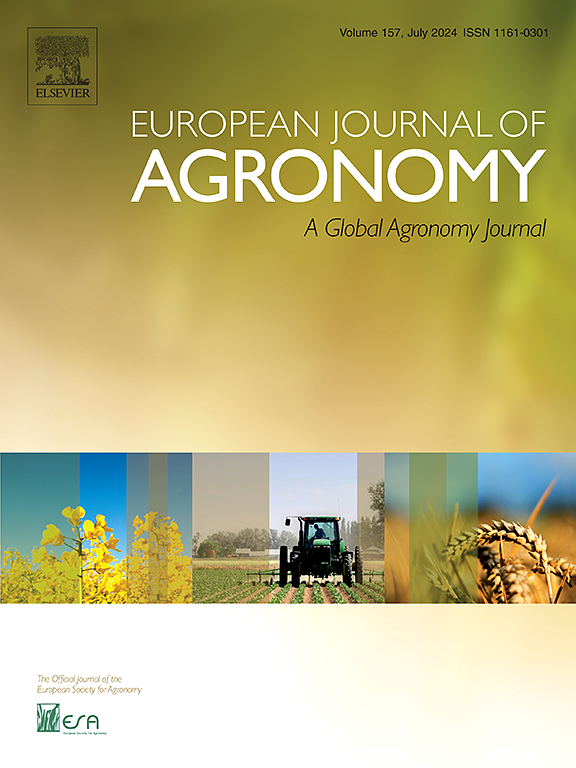评价不同施氮量下生物刺激素对玉米生产的影响
IF 5.5
1区 农林科学
Q1 AGRONOMY
引用次数: 0
摘要
生物刺激素因其在优化氮素吸收和氮素利用效率(NUE)的同时提高作物生产力的潜力而引起了人们的极大兴趣。然而,实地研究测试了它们在玉米(玉米)中的功效。L)生产大部分仍未开发。因此,于2022年和2023年在密西西比州(MS)进行了实地研究。采用分割小区设计,以施氮量为主要小区,斯塔克维尔施氮量为0(对照)、90、180、269 kg N ha−1,斯通维尔施氮量为224 kg N ha−1。该亚区包括7个处理,包括无生物刺激素(检查)和6个微生物刺激素(Source Corn®,Envita®,vigor®,Blue N®,Micro AZ™和Bio level phosN®),在V4-V5生长期在叶面施用或在种植时在沟内施用。施氮量在所有三个站点年都对粮食产量产生积极影响,而生物刺激剂对粮食产量的影响仅在一个站点观察到(Stoneville 2022)。这些差异仅存在于6种生物刺激剂之间,与未使用生物刺激剂的对照区差异不显著。从氮素利用效率参数和氮素吸收方面看,较高的施氮量降低了粮食生产效率,并在所有立地年表现出一致的反比趋势。尽管评估了微生物刺激剂在不同施氮率下的有效性,但本研究观察到微生物刺激剂的协同效益最小。有必要进行进一步的研究,测试不同剂量和使用时间的各种生物刺激素类别,以确认它们对提高生产力和农业可持续性的潜在益处。本文章由计算机程序翻译,如有差异,请以英文原文为准。
Evaluating the impact of biostimulants at variable nitrogen rates in corn production
Biostimulants have garnered significant interest due to their potential to enhance crop productivity while optimizing nitrogen (N) uptake and nitrogen use efficiency (NUE). However, field research testing their efficacy in corn (Zea mays. L) production remains largely unexplored. Therefore, a field study was conducted in 2022 and 2023 in Mississippi (MS). A split plot design was implemented, with N rates as the main plot including 0 (control), 90, 180, 269 kg N ha−1 at Starkville, while Stoneville included an additional rate of 224 kg N ha−1. The subplot consisted of seven treatments, including a no biostimulant (check) and six microbial biostimulants (Source Corn®, Envita®, iNvigorate®, Blue N®, Micro AZ™, and Bio level phosN®) applied either as foliar at V4-V5 growth stages or in-furrow at planting. Nitrogen rates positively affected grain yield at all three site-years, whereas biostimulants effects on grain yield were only observed at one site (Stoneville 2022). Moreover, these differences only existed between six biostimulants and they were not significantly different from check plot with no biostimulant. Higher N rates reduced the efficiency of grain production in terms of NUE parameters and N uptake, showing a consistent inverse trend across all site years. This study observed minimal synergistic benefits of microbial biostimulants, despite evaluating their effectiveness alongside varied N rates. Further research testing diverse biostimulant categories with varied dosages and application timings is warranted to confirm their potential benefits for higher productivity and agricultural sustainability.
求助全文
通过发布文献求助,成功后即可免费获取论文全文。
去求助
来源期刊

European Journal of Agronomy
农林科学-农艺学
CiteScore
8.30
自引率
7.70%
发文量
187
审稿时长
4.5 months
期刊介绍:
The European Journal of Agronomy, the official journal of the European Society for Agronomy, publishes original research papers reporting experimental and theoretical contributions to field-based agronomy and crop science. The journal will consider research at the field level for agricultural, horticultural and tree crops, that uses comprehensive and explanatory approaches. The EJA covers the following topics:
crop physiology
crop production and management including irrigation, fertilization and soil management
agroclimatology and modelling
plant-soil relationships
crop quality and post-harvest physiology
farming and cropping systems
agroecosystems and the environment
crop-weed interactions and management
organic farming
horticultural crops
papers from the European Society for Agronomy bi-annual meetings
In determining the suitability of submitted articles for publication, particular scrutiny is placed on the degree of novelty and significance of the research and the extent to which it adds to existing knowledge in agronomy.
 求助内容:
求助内容: 应助结果提醒方式:
应助结果提醒方式:


